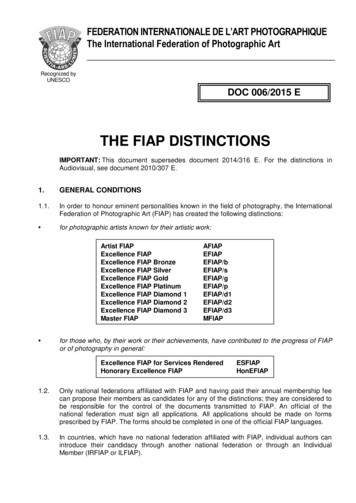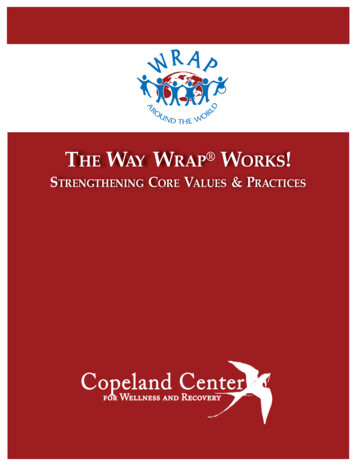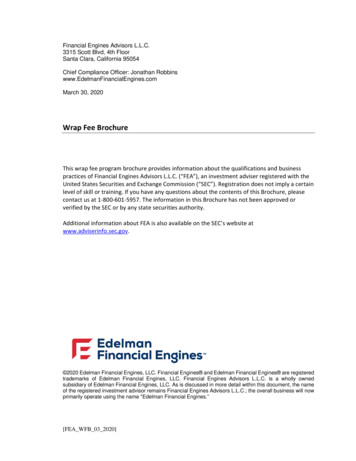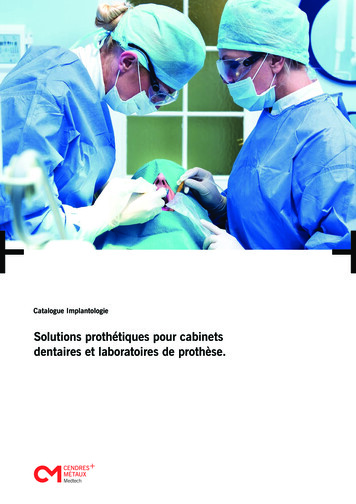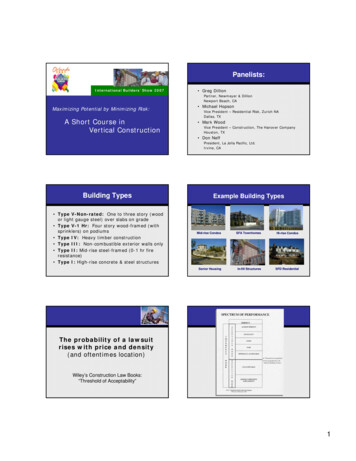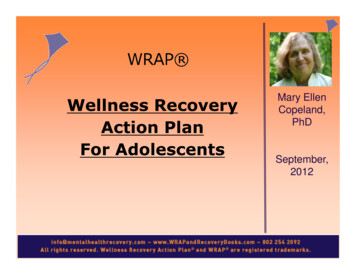
Transcription
Wellness RecoveryAction PlanFor AdolescentsMary EllenCopeland,PhDSeptember,2012
Letty Elenes, Kimberly Marquez, AngelCortes, Rocio Elenes, Pedro Alvarez, LalaDoost, Ed Anthes and Hannah Smith
WRAP is a simple, safe, self-determinedprocess for assessing personal resourcesand using those resources to:1. Feel better2. Stay well3. Make your life the way you want itto be4. Do the things you want to do
WRAP Includes: Wellness Toolbox Daily Maintenance Plan Triggers and Action Plan Early Warning Signs and Action Plan When Things are Breaking Down and Action Plan Crisis Plan or Advance Directive Post Crisis Planning
Why WRAP for Adolescents1. Time of change and difficult transitions New responsibilities and experiences Diminished family supervision and support Strategies that used to work no longer work2. Opportunity to develop self awareness3. Teaches personal responsibility and selfadvocacy4. Build new habits and life strategies5. Helps discover interests and opportunities
People often develop mental healthchallenges like psychosis, anxiety,depression, suicidality, mania at thistime.WRAP is a safe, common sense way toaddress or deal with these issues.
Use WRAP to AddressIssues like:Going away to schoolLeaving home, friends, jobs, or communityFinding a new home space, new friends, anew communityBeginning or ending a relationshipTrying out new experiencesStarting new jobs
Feeling "burned out" Not getting any pleasure out of living Irritable and annoyed much of the time Constantly tired Lacking motivation Working too much Addictions Weight related issues New situations and experiences
WRAPThere is only one person who can write a WRAPThe person whowill be using it!Only they can decide: If they want a WRAP How much time they taketo develop it When they do it Which parts they want to do
WRAPThey decide: If they want anyone to help with it If they want to attend a WRAP group How they use it Who they show it to Where they keep it Who, if anyone, has copies of their CrisisPlan
WRAPMost adolescents willchoose to developtheir WRAP on acomputer using The“WRAP for YourComputer” Or the“Build Your OwnWRAP” programs.In several months wewill have a WRAPAPP. and a book WRAPfor Youth.
Begin a WRAP by:They begin by developing a list of theirWellness Tools.These are the things they do to keepthemselves well, to find satisfaction inliving and to enjoy life, and the thingsthey do to help them self feel better whenthey don’t feel well or are having difficultycoping.
Developing a WellnessToolboxThey may have discovered their ownwellness tools or learned about them fromothers.Most of them are simple, safe, and free.They will use these tools to develop theirWRAP.
Wellness Tool Ideas Doing things that divert theirattention/things they enjoy Journal writing Eating or avoiding certain foods Exercise Being outdoors
Listening to or playing music Going to a concert or movie with friends “Hanging out” with friends Playing sports or watching sports Doing a creative art project Taking a shower Painting my nails
Wellness ToolsThey will be able to think of many otherWellness Tools that are helpful to them.
Daily Maintenance ListThe first section is Daily MaintenancePlan.On the first page, they describe whatthey are like when they are feelinggreat.
Daily Maintenance ListSome words that others have used hdrawn
Daily Maintenance ListThey may want to include on this pagespecific things they want to work on in theirWRAP like:Building Self-EsteemImproving a relationship or ending arelationshipGetting a Different JobEnjoying life
Daily Maintenance ListThen they make a list of things they feelthey need to do every day to keep feelingwell, things like:Getting up at a specific timeEating breakfastGoing to school or workTaking a showerSpending time with friendsAvoiding alcohol
Daily Maintenance ListThen they make a reminder list of things theymight choose or need to do on any specific day.Reading through this list daily and doing thosethings that need to be done reduces stress andhelps them stay on track.
Daily Maintenance List Getting more sleep Seeing a vocational counselorArranging a jobinterviewWorking on a specialprojectBuying groceriesPersonal timePlanning somethingfun for the weekend
IdentifyingTriggersTriggers are upsetting events orcircumstances that make them feel awful.These are normal reactions to life events but if they don’t address them, they maymake them feel worse and worse overtime.
TriggersExamples: Arguments with friendsWork or school stressFamily FrictionBreaking up with a partnerSexual harassmentTeasing, bullyingBeing treated badlyPhysical illnessFeeling left outParents nagging
Triggers Action PlanThey list choices of Wellness Tools they can use tohelp themselves feel better if a trigger happens.Vent with a supporterPlay with my dogWatch a funny videoPlay my guitarPunch a pillowVigorous exerciseSurround myself with people whounderstand meAdvocate for myselfDo some deep breathingDo an art project
Early Warning SignsEarly Warning Signs are internal and may beunrelated to reactions to stressful situations.They are subtle signs of change that indicatethey may need to take some further action.
Early Warning Signs Not able to sleep Making bad decisions Feeling like I am no good Feel like I am walking on eggshells Feeling ugly Feeling like nobody likes me
Early Warning Signs Forgetfulness Anxiety or Nervousness Inability to Experience Pleasure Lack of Motivation Feeling Slowed Down or Speeded Up Loss of appetite—or eating “a lot”
Early Warning SignsAction PlanThey develop a plan of Wellness Tools touse every day until they feel better – aplan they feel will keep them from feelingworse and help them to feel better if theynotice Early Warning Signs.
Early Warning SignsAction PlanSample Plan: Do three 10 minute relaxation exercises Spend at least 1 hour involved in anactivity I enjoy Ask others to take over my responsibilities Play my drums for at least ½ hour Avoid junk food and caffeine Get to bed by 11 each night and get up by8:30 Ask for extensions on my homework
Early Warning SignsAction Plan Spend extra time with good friends Take a day off from school or work Make a list of things that make me laugh Work on a favorite art project for at least ½ hourRead a good bookExercise for at least ½ hourGo to an uplifting eventGet a check-up with my doctor
When Things are BreakingDown or Getting WorseThey may begin to feel much worse, like the situationis serious – and even dangerous – but they are stillable to take some action in their own behalf.This is a very important time. It is necessary forthem to take immediate, assertive action toprevent a crisis.
When Things are BreakingDown or Getting WorseThey make a list of the feelings andbehaviors which mean that things haveworsened and are close to the crisis.
When Things are BreakingDown or Getting Worse Can’t concentrate at school or work Losing track of what I’m doing Feeling very oversensitive and fragile Irrational responses to others
When Things are BreakingDown or Getting Worse Feeling very needy Unable to sleep for (how long?) Sleeping all the time Avoiding eating Racing thoughts Not wanting to be with anyone
When Things are BreakingDown or Getting WorseThey then develop an action plan to use each daythey experience the signs “When Things areBreaking Down” until they no longer experiencethese signs.The plan now needs to be clear and directive withmany Wellness Tools they “must” use and fewerchoices. As with the rest of the plan, they decidewhat they will do.
When Things are Breaking Downor Getting Worse Action PlanThings I must do each do until I no longer havethese signs:Stay home from school or workDo all the things on my Daily Maintenance ListExercise vigorously for at least ½ hourSpend at least 1 hour playing or listening tomusic Spend at least 1 hour working on a creative artproject Check in with my counselor or doctor Talk to a supporter for at least 15 minutes
When Things are Breaking Downor Getting Worse Action PlanThings I might choose do:Work on scrapbookingTake pictures of things I loveMake a list of my accomplishmentsText with my friendsOrder a pepperoni pizza and share it with afriend Anything on my list of Wellness Tools
CrisisPlanning/AdvanceDirectiveThey write their Crisis Plan when they are feelingOK. The plan will instruct others about how tocare for them when they cannot take care ofthemselves.It keeps them in control even when it seems likethings are out of control.
Crisis PlanningOthers will know what to do, saving everyone time andfrustration, while insuring that their needs will be met.They need to develop this plan slowly when they arefeeling OK.
CrisisPlanning/AdvanceDirectiveThis part of WRAP is different from other partsof the plan because they will give it to thosepeople they want to support them in advanceso they have it when needed.
Advance Directive/Crisis Planning1.What you are like when you are well2.Indicators that others need to “take over”Who “takes over” and who doesn’t4. Information on health care contacts andmedications5. Acceptable and unacceptable treatments6. Home/Community Care/Respite Plan3.
Advance Directive/Crisis Planning7. Things others can do that would help8.Things other might do that would make you feel worse9. A list of chores and tasks for others10. Indicators that the plan is no longer needed11. Signatures of key people
Post Crisis PlanningThe time when they are healing from acrisis can be very important.Although they feel ready to begin takingcare of them self again, they may still bedealing with difficult feelings and behaviorsas well as the aftermath of the crisis.They may find that they are starting to feelworse – like they are heading for anothercrisis.
Post Crisis PlanningThinking about this time before they evenhave a crisis, and perhaps giving it moreattention when they are starting to feelbetter after a crisis, may help them havean easier time recovering and moving on.
WRAPThey can begin using their WellnessRecovery Action Plan as their guide todaily living whenever they want to. Theydon’t have to complete it to use it.
WRAPAt first they may want to review their planevery day, following their Daily MaintenancePlan, and taking other action as needed.
WRAPAfter a while they will notice that theyremember their plan and only need to referto it from time to time, unless they arehaving a difficult time.
WRAPThey may want to revise their plan whenthey discover new Wellness Tools and findthat some things work better for themthan others.
Hope Personal Responsibility Education Self Advocacy Support
1. It is understood that there is hope, that peoplecan get well, stay well for long periods of time, and dothe things they want to do with their lives.2. Self determination, personal responsibility,empowerment, and self-advocacy are stressed.
3. They are encouraged to make their own decisions,or when applicable make decisions with the group, andpersonal sharing is encouraged.4. They must be treated with dignity, compassion,mutual respect, and unconditional high regard at alltimes, and as equal to all others.5. They are accepted unconditionally as a unique andspecial person, including acceptance of diversity ofculture, ethnicity, language, religion, race, gender, age,disability, sexual identity, and ability.
6. It is understood that there are "no limits" to recovery.7. They are always given the opportunity to explorechoices and options, and are not expected to easilyfind simple, final answers.8. All participation is voluntary.9. It is understood that they are the expert on themself.
10. The focus is on individual strengths, and away fromperceived deficits.11. Clinical, medical, and diagnostic language isavoided.13. Recommended strategies are simple and safe foranyone. Strategies that may have harmful effects, orare potentially dangerous are not suggested orrecommended.
14. Difficult feelings and behaviors are seen asnormal responses to traumatic circumstances and inthe context of what is happening, and not as“symptoms” or as confirmation of a diagnosis.
NaggingThreats, coercion, shoutingPutting your expectations on themEncouraging or telling them they have todo specific things before they are ready
Be kind, warm, gentle, loving andunderstanding even when it is hardListen, Listen, Listenwithout interrupting with stories of yourown
SAVE THE DATE January 25-27, 2013 Oakland City CenterMarriott Please join us for thesecond internationalconference!
For information on WRAP training,WRAP groups and WRAP forAdolescents ProgramsVisit www.copelandcenter.com
Many, many WRAP resources The WRAP Story WRAP Plus Winning Against Relapse The Depression Workbook WRAP books
WRAP Includes: Wellness Toolbox Daily Maintenance Plan Triggers and Action Plan Early Warning Signs and Action Plan When Things are Breaking Down and Action Plan Crisis Plan or Advance Directive Post Crisis Planning
Wellness Recovery Action Plan (WRAP)Wellness Recovery Action Plan (WRAP) is a manualized group intervention for adults with mental illness. WRAP guides participants throughthe process of identifying and understanding their personal wellness resources ("wellness tools") and then helps them develop anindividualized plan to use these resources on a daily basis to manage their mental illness. WRAP has the following goals:llllTeach participants how to implement the key concepts of recovery (hope, personal responsibility, education, self-advocacy, andsupport) in their day-to-day livesHelp participants organize a list of their wellness tools--activities they can use to help themselves feel better when they areexperiencing mental health difficulties and to prevent these difficulties from arisingAssist each participant in creating an advance directive that guides the involvement of family members or supporters when he or shecan no longer take appropriate actions on his or her own behalfHelp each participant develop an individualized postcrisis plan for use as the mental health difficulty subsides, to promote a return towellnessWRAP groups typically range in size from 8 to 12 participants and are led by two trained cofacilitators. Information is imparted throughlectures, discussions, and individual and group exercises, and key WRAP concepts are illustrated through examples from the lives of thecofacilitators and participants. The intervention is typically delivered over eight weekly 2-hour sessions, but it can be adapted for shorter orlonger times to more effectively meet the needs of participants. Participants often choose to continue meeting after the formal 8-weekperiod to support each other in using and continually revising their WRAP plans.Although a sponsoring agency or organization may have its own criteria for an individual's entry into WRAP, the intervention's only formalcriterion is that the person must want to participate. WRAP is generally offered in mental health outpatient programs, residential facilities,and peer-run programs. Referrals to WRAP are usually made by mental health care providers, self-help organizations, and other WRAPparticipants. Although the intervention is used primarily by and for people with mental illnesses of varying severity, WRAP also has beenused with people coping with other health issues (e.g., arthritis, diabetes) and life issues (e.g., decisionmaking, interpersonal relationships)as well as with military personnel and veterans.Descriptive InformationAreas of InterestMental health treatmentOutcomesReview Date: September 20101: Symptoms of mental illness2: Hopefulness3: Recovery from mental illness4: Self-advocacy5: Physical and mental healthOutcomeCategoriesMental healthQuality of lifeSocial functioningTreatment/recoveryAges26-55 (Adult)GendersMaleFemaleRaces/EthnicitiesAmerican Indian or Alaska NativeAsianBlack or African AmericanHispanic or LatinoWhiteRace/ethnicity unspecified
SettingsResidentialOutpatientOther community settingsGeographicLocationsUrbanSuburbanRural and/or frontierImplementationHistoryIn 1997, WRAP was first implemented, and the first edition of the book "Wellness Recovery Action Plan" waspublished. Since then, more than a million WRAP books and related resources have been distributed worldwide,and millions of people have benefited from the WRAP intervention. Formal training for WRAP facilitators wasfirst offered in 1997, and the first edition of the structured WRAP facilitator training manual, "Mental HealthRecovery Including Wellness Recovery Action Plan Curriculum," was published in 1998. The not-for-profitCopeland Center for Wellness and Recovery was established in 2005 with a mission to implement and networkthe WRAP training model, nationally and internationally. As of February 2010, more than 2,000 people hadbeen trained as a WRAP facilitator, and 120 of these individuals had been trained as an advanced-levelfacilitator. Trainings have been conducted in Australia, Canada, England, Hong Kong, Ireland, Japan, NewZealand, Scotland, and the United States, and WRAP groups, which are conducted by trained facilitators, existin these countries. In the United States, local and regional WRAP programs sponsored by mental healthagencies and peer-run centers exist in every State, and over 25 States have integrated statewide WRAPinitiatives. There have been at least six evaluations of this intervention in the United States, as well as one inNew Zealand and one in Scotland.NIHFunding/CERStudiesPartially/fully funded by National Institutes of Health: YesEvaluated in comparative effectiveness research studies: NoAdaptationsThe book "Wellness Recovery Action Plan" and other WRAP implementation materials have been translated intomany languages, including Chinese, French, Japanese, Polish, and Spanish. In addition, many internationaltrainings and presentations have been adapted to accommodate unique cultural perspectives on mental health,language differences, and cultural norms.Adverse EffectsPreliminary data analysis conducted for a study published in 2009 by Cook et al. (see Study 2) indicated thatparticipation in WRAP may have had negative effects on empowerment. However, this finding has not beenreplicated in subsequent evaluations and analyses with larger samples. To date, no additional accounts ofadverse effects of WRAP have been published.IOM PreventionCategoriesIOM prevention categories are not applicable.Quality of ResearchReview Date: September 2010Documents ReviewedThe documents below were reviewed for Quality of Research. The research point of contact can provide information regarding the studiesreviewed and the availability of additional materials, including those from more recent studies that may have been conducted.Study 1Cook, J. A., Copeland, M. E., Jonikas, J. A., Hamilton, M. M., Razzano, L. A., Grey, D. D., et al. (2010). Results of a randomized controlledtrial of mental illness self-management using Wellness Recovery Action Planning. Manuscript submitted for publication.Study 2Cook, J. A., Copeland, M. E., Hamilton, M. M., Jonikas, J. A., Razzano, L. A., Floyd, C. B., et al. (2009). Initial outcomes of a mental illnessself-management program based on Wellness Recovery Action Planning. Psychiatric Services, 60(2), 246-249.Supplementary MaterialsUniversity of Illinois at Chicago (UIC) National Research and Training Center (NRTC) Ohio (OH) WRAP Study: Fidelity ScaleOutcomesOutcome 1: Symptoms of mental illnessDescription of MeasuresSymptoms of mental illness were assessed using the Brief Symptom Inventory (BSI), a 53-item
self-report instrument. The BSI yields scores on the Global Severity Index (an overall measure ofpsychological distress), the Positive Symptom Total (a measure of the number of symptoms), andnine symptom subscales: somatization, obsessive-compulsive, interpersonal sensitivity, depression,anxiety, hostility, phobic anxiety, paranoid ideation, and psychoticism. Using a 5-point scale rangingfrom "not at all" to "extremely," participants rate each item for how much the symptom botheredthem in the past week.Key FindingsParticipants were randomly assigned to an intervention group that received WRAP or to a wait-listcontrol group that received services as usual. The BSI was administered to participants 6 weeksbefore (baseline) and 6 weeks after (posttest) they received the intervention and at a 6-monthfollow-up. WRAP participants had a significantly greater reduction in the severity and number ofsymptoms across time (from baseline to posttest to 6-month follow-up) relative to control groupparticipants, as indicated by scores on the BSI Global Severity Index (p .023); Positive SymptomTotal (p .027); and subscales measuring interpersonal sensitivity (p .023), depression (p .022), anxiety (p .022), phobic anxiety (p .034), and paranoid ideation (p .009). Nostatistically significant differences were found between the two groups across time on somatization,obsessive-compulsive, hostility, and psychoticism subscales.Studies Measuring OutcomeStudy 1Study DesignsExperimentalQuality of Research Rating3.9 (0.0-4.0 scale)Outcome 2: HopefulnessDescription of MeasuresHopefulness was assessed using the Hope Scale (HS), a 12-item self-report instrument with twosubscales: one that measures belief in one's capacity to initiate and sustain actions and anotherthat measures ability to generate routes by which goals may be reached. Participants rate each itemon a 4-point scale ranging from "definitely false" to "definitely true," and scores for each item aresummed to produce a total score.Key FindingsIn one study, participants were randomly assigned to an intervention group that received WRAP orto a wait-list control group that received services as usual. The HS was administered to participants6 weeks before (baseline) and 6 weeks after (posttest) they received the intervention and at a 6month follow-up. WRAP participants had a significantly greater improvement in hopefulness acrosstime (from baseline to posttest to 6-month follow-up) relative to control group participants, asindicated by total HS scores (p .018) and the subscale for belief in one's capacity to initiate andsustain actions (p .020). No statistically significant difference was found between the two groupsacross time on the subscale for ability to generate routes by which goals may be reached.In another study, the HS was administered to participants before (pretest) and 1 month after(posttest) they received the intervention. From pre- to posttest, participants who received WRAPhad a significant increase in feelings of hopefulness, as indicated by scores on the two HS subscales(p .01 for each subscale).Studies Measuring OutcomeStudy 1, Study 2Study DesignsExperimental, PreexperimentalQuality of Research Rating3.7 (0.0-4.0 scale)Outcome 3: Recovery from mental illnessDescription of MeasuresRecovery from mental illness was assessed using the Recovery Assessment Scale (RAS), a 41-itemself-report instrument with five subscales: personal confidence, willingness to ask for help, goalorientation, reliance on others, and freedom from symptom domination. Participants rate each itemon a 5-point scale ranging from "strongly agree" to "strongly disagree," and scores for each itemare summed to produce a score for overall recovery.Key FindingsThe RAS was administered to participants before (pretest) and 1 month after (posttest) theyreceived the intervention. From pre- to posttest, WRAP participants had a significant improvementin RAS scores for overall recovery (p .001) and in the five subscales: personal confidence (p
.001), willingness to ask for help (p .05), goal orientation (p .05), reliance on others (p .05), and freedom from symptom domination (p .05).Studies Measuring OutcomeStudy 2Study DesignsPreexperimentalQuality of Research Rating3.3 (0.0-4.0 scale)Outcome 4: Self-advocacyDescription of MeasuresSelf-advocacy was assessed using the Patient Self-Advocacy Scale (PSAS), a 12-item self-reportinstrument that measures three dimensions: patient knowledge, assertiveness, and potential fornonadherence to treatment. Participants rate each item on a 5-point scale ranging from "stronglyagree" to "strongly disagree."Key FindingsThe PSAS was administered to participants before (pretest) and 1 month after (posttest) theyreceived the intervention. From pre- to posttest, WRAP participants had a significant improvementin self-advocacy, as indicated by scores in all three dimensions (p .01 for each dimension).Studies Measuring OutcomeStudy 2Study DesignsPreexperimentalQuality of Research Rating3.3 (0.0-4.0 scale)Outcome 5: Physical and mental healthDescription of MeasuresPhysical and mental health was assessed using the Medical Outcomes Study 12-Item Short FormSurvey (SF-12), a self-report instrument that evaluates health indicators, allowing for examinationof the presence and seriousness of physical and mental conditions, acute symptoms, age andaging, changes in health, and recovery from depression.Key FindingsThe SF-12 was administered to participants before (pretest) and 1 month after (posttest) theyreceived the intervention. From pre- to posttest, WRAP participants had a significant improvementin physical and mental health (p .01).Studies Measuring OutcomeStudy 2Study DesignsPreexperimentalQuality of Research Rating3.3 (0.0-4.0 scale)Study PopulationsThe following populations were identified in the studies reviewed for Quality of Research.StudyAgeGenderRace/EthnicityStudy 126-55 (Adult)66% Female34% Male63% White28% Black or African American5% Hispanic or Latino3% American Indian or Alaska Native1% AsianStudy 226-55 (Adult)64% Female36% Male66% White25% Black or African American5% Race/ethnicity unspecified4% Hispanic or LatinoQuality of Research Ratings by Criteria (0.0-4.0 scale)External reviewers independently evaluate the Quality of Research for an intervention's reported results using six criteria:
1. Reliability of measures4. Missing data and attrition2. Validity of measures5. Potential confounding variables3. Intervention fidelity6. Appropriateness of analysisFor more information about these criteria and the meaning of the ratings, see Quality of aAnalysisOverallRating1: Symptoms of mental illness4.04.04.04.03.54.03.92: Hopefulness4.04.03.63.43.04.03.73: Recovery from mental illness4.04.02.82.82.04.03.34: Self-advocacy4.04.02.82.82.04.03.35: Physical and mental health4.04.02.82.82.04.03.3OutcomeStudy StrengthsAll outcome measures used in both studies have strong, well-established psychometric properties. Both studies assessed fidelity thoughmultiple methods, including a checklist that documented adherence to prescribed topics, timeframes, and instructional modalities; weeklyteleconference calls by the research team and the study's local WRAP coordinators to discuss each site's attendance and fidelity scores;and the use of trained, experienced facilitators. One study used random assignment and found no significant baseline differencesbetween the intervention and control groups in regard to demographics, clinical status, and employment status. Attrition in both groupsfor this study was relatively low and was addressed appropriately in the analyses. The same study used a strong experimental design tominimize potential bias owing to confounding variables. Both studies' analytic strategy for data was thorough and appropriate.Study WeaknessesThe instrument used in both studies to assess intervention fidelity has unknown psychometric properties. One study used apreexperimental design and had high attrition. The other study did not provide adequate information on the services received by thecontrol group, such as exposure to peer-led support groups and medications, which raises concerns about potential confounds.Readiness for DisseminationReview Date: September 2010Materials ReviewedThe materials below were reviewed for Readiness for Dissemination. The implementation point of contact can provide informationregarding implementation of the intervention and the availability of additional, updated, or new materials.Copeland, M. E. (1999). Winning against relapse: A workbook of action plans for recurring health and emotional problems. Dummerston,VT: Peach Press.Copeland, M. E. (2001). The depression workbook: A guide for living with depression and manic depression (2nd ed.). Oakland, CA: NewHarbinger Publications.Copeland, M. E. (2006). Wellness Recovery Action Planning (WRAP) project: WRAP group facilitator's kit.Copeland, M. E. (2009). Facilitator training manual: Mental health recovery including Wellness Recovery Action Plan curriculum.Dummerston, VT: Peach Press.Copeland, M. E. (2010). WRAP facilitator manual.Copeland, M. E., & Mead, S. (2004). Wellness Recovery Action Plan and peer support: Personal, group, and program development.Dummerston, VT: Peach Press.My WRAP [Participant binder]Program Web site for facilitators, http://www.copelandcenter.comProgram Web site for participants, http://www.mentalhealthrecovery.com
University of Illinois at Chicago (UIC) Courses in Recovery Study: WRAP Fidelity AssessmentReadiness for Dissemination Ratings by Criteria (0.0-4.0 scale)External reviewers independently evaluate the intervention's Readiness for Dissemination using three criteria:1. Availability of implementation materials2. Availability of training and support resources3. Availability of quality assurance proceduresFor more information ab
Things I must do each do until I no longer have these signs: Stay home from school or work Do all the things on my Daily Maintenance List Exercise vigorously for at least ½ hour Spend at least 1 hour playing or listening to music Spend at least 1 hour working on a creative art project Check in with my counselor or doctor Talk to a supporter for at least 15 minutes


